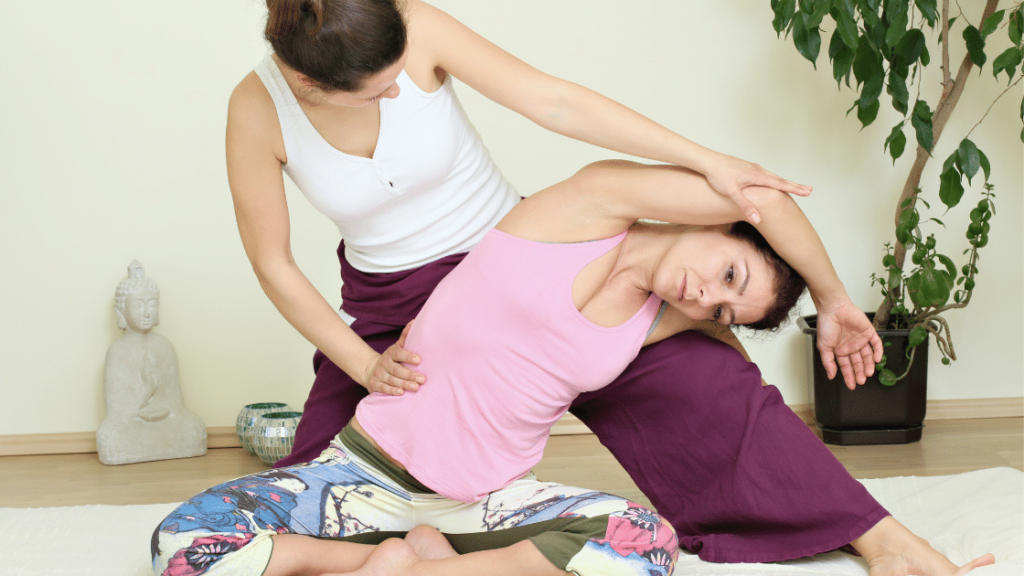Why Combine Massage and Yoga?

Have you ever heard of a thing called yogassage? It’s sometimes called yoga-massage, is similar to Thai massage, and is talked about a little bit in the blog The Therapeutic Massage for You.
What Happens When You Add Massage and Yoga to Your Health Regimen
If you’ve had yogassage before, then you already know why yoga and massage complement each other! If you haven’t, I’ll explain why you should combine the two! And you don’t necessarily have to get a yogassage, though I highly recommend it. You can just add both massage and yoga to your health regimen if you’d rather do that. Watch what happens!
You’ll Double the Therapeutic Benefits
Massage and yoga share plenty of benefits. Here are just a few they both do!
- Relax the mind and body
- Relieve pain
- Improve circulation
- Improve respiration
- Improve posture
- Strengthen muscles
- Enhance physical performance
- Promote restful sleep
- Prevent injury
- Increase flexibility
Now, what’s better than experiencing those ten bullet points? Multiplying those benefits by two, of course!
When you receive a massage, your breathing slows, which in turn calms your mind. Yoga, putting an emphasis on mindful breathing, also promotes relaxation. So, imagine you’re receiving that relaxing massage, all the while being guided by a calming voice reminding you to breathe gently. So soothing… and just picture how you’ll sleep that night. You already get pretty nice sleep after (or during) massages, and a little extra relaxation may give you the ultimate sleep!
Now think about some of those other mentioned benefits, which clearly aren’t going in any particular order. It’s common knowledge that yoga strengthens the body, improves flexibility, and therefore enhances physical performance. But something many of us forget is that massage offers those benefits too. You may be the type of person who does yoga at the end of an intense workout. Or, perhaps you’re the type of person who does really intense yoga; I’m talking about those Pungu Mayurasana folks. You might be tired after that workout, and a post-exercise massage is a great idea! Now get ready — all that strength, flexibility, and athletic performance you just promoted will get promoted again!
But how does massage improve strength, flexibility, and athletic performance? Well, sore muscles have a negative impact on all three of those. Pain relief, the most well known massage benefit besides relaxation, lets your muscles perform more efficiently again. Having fitness goals alone is a good reason to combine yoga and massage.
Oh, wow. The more I write, the more overlap I encounter with these benefits. I just told you that massage relieves pain, and that pain improves physical performance. And before I told you that, I said that yoga improves physical performance. But yoga, like massage, can also relieve pain! I feel like I’m talking in circles. Got back pain? Get some cat-cow and downward dog in your yoga routine. Those will gently stretch your back, giving you some relief. After that, find someone to knead that area you just stretched and you’ll feel amazing.
Ok, so what haven’t we touched base on… circulation, posture, and injury prevention. Let’s get to it! The pressure from a massage literally moves blood to congested areas of your body. All forms of exercise, even very basic yoga poses, also increase blood flow. Healthy blood flow makes a healthy heart, so increase the chances of a healthy heart by having two circulation boosters in your life.
And as for posture and injury prevention, the two go hand in hand. Do you know what percentage of injuries are due to poor posture? It’s a lot of them. That inability to turn your neck without pain? Likely due to slouching. That aching lower back? You probably slept in a weird position. Now, posture is a really hard thing to fix on our own. On behalf of our activities of daily living, which often involve sitting, almost nobody has perfect posture. And most of us have sore shoulders as a result. So what can be done to remedy this? If you’ve been reading this article, then you know the answer is yoga and massage. Certain yoga poses, such as Reverse Namaste, open your chest. An open chest keeps your shoulders back and your spine straight. As for massage improving posture, remember when I talked about pain relief and physical performance? Physical performance doesn’t just entail proper form while exercising or completing daily activities with ease. It also includes having the strength to hold yourself upright. And that ability to stay upright will prevent posture related injury.
You see, it’s all connected. One benefit will encourage another benefit, and the best way to get those benefits is to find more than one way to obtain them. Combine them!
Here’s what to do!
- Find out if yogassage is for you. You’ll never know unless you try. Set up an appointment with Scott!
- Set aside time in your schedule for both yoga and massage, if you want to do them separately. How often will you get a massage and how much time do you have for yoga?
- Know your body. What yoga poses are you most comfortable doing? What type of massage do you benefit from the most? Don’t hurt yourself!
As always, stay happy and healthy! (And do massage and yoga!)

Katrina Jenkins
Author, Licensed Massage Therapist
Katrina Jenkins graduated from Towson University in 2013 with a Bachelor’s Degree in Health Science and worked as a nurse’s aide briefly before pursuing her true passion. She graduated from the Massage Therapy Institute of Colorado in April 2016 with honors and completed the Touch of Healers Scholarship Program the following summer. She has been a part of the Moyer Total Wellness Team since the summer of 2017.
